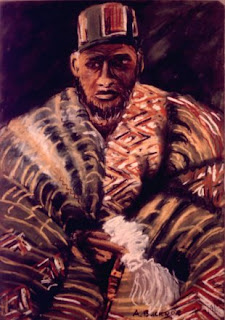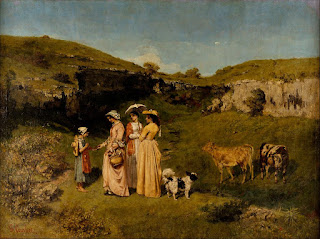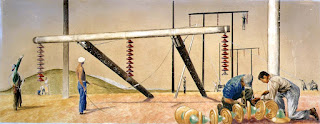Classical
One cannot discuss the intersection of Revolution & Art in the 1700s, without mentioning the American Revolutionary War and the powerful images that arose during this period. This period is filled with historic figures whose profiles can be captured by many of the portraits that have been painted over the centuries. One of the biggest names of the revolutionary war era is Paul Revere, who was a patriot who warned about the oncoming British invasion in the lead up to the Revolutionary War. One of the notable paintings of Paul Revere was done by John Singleton Copley in 1768:
Paul Revere by John Singleton Copley, 1768Revolution and Art in the 1700s were symbolic, emphasized reason, and involved a lot of patriotism. Especially with neoclassicalism paintings, such as this one. Although this painting by Copley was done in 1768, it's difficult to know exactly where this painting was done. Some people might assume Boston, since this portrait of Revere is located in the Museum of Fine Arts in Boston, Massachusetts. Copley's painting of Revere presents him as being no different than the average regular individual. The presentation of Revere presents in a positive light, and makes him to be a pleasant and likeable individuals. The use of a black-color background allows us to focus on Revere, and the placement of his hand underneath his chin & with him staring at what is in front of him makes him of significant focus. The use of curved lines add to the seriousness of his appearance and presentation. Revere's form appears very well-balanced, which was typical of portraits of American revolutionary figures. Given the clothing that Revere is wearing, one can could conclude that the texture in the portrait is soft. In addition, there's plenty of open space around Revere's shoulders in painting. There doesn't appear to be any noticeable patterns, except for the edges of the table desk that Revere is resting his elbow on. The value for this painting appears to be low-contrast. Lastly, with regards to shape, everything that is presented by Copley has an organic shape. The elements in this painting do help to draw my attention, as they assist me in looking at the Paul Revere's face and his hands. The emotions that are elicited by this painting is one of appreciation. It gives decent vibes. I would love to have a copy of this painting, but I think it would be best suited if its original were to remain in the custody of places like the Museum of Fine Arts, where people from all over the world could appreciate the history of figures during the Revolution, like Paul Revere. As for there being any backstory behind this painting by Copley; it's believed that Copley painted this painting of Paul Revere to highlight Revere's profession as an artisan and his appreciation for the work that artisans do, which was a profession that Copley had as well. In a way, it celebrates the work of the average man, which would consist of one's ability to be able to work with their hands. This is how I, as an everyday working class individual, sees himself. This also explains how I can relate to Copley's painting. Nevertheless, Art & Revolution in the 1700s carried messages of patriotism, glory, and honor. Looking at Copley's painting of Revere, Copley presents Revere in an honorable manner & displays the image of an artisan that's gifted with talent and expressing intelligence.
Matilda Stoughton de Jaudenes by Gilbert Stuart, 1794.
Another painting that caught my attention was this done by Gilbert Stuart in 1794 of a 16-year old daughter of a Spanish consul known as Matilda Stoughton de Jaudenes. This painting of Matilda reflects the modest and elegant style of clothing during this period of art in the 1700s. Like Copley, Stuart's portrait of Matilda shows how the subject in the painting is the center of attention, and that subjects attention is focused back at the illustrator/painter. Stuart makes good use of curved lines to highlight some of the accessories of Matilda's attire and dress. The use of light colors by Stuart presents Matilda in a positive light, and increases her profile. Art during the Revolution era of the 1700s were known to have paintings of high profiled individuals. The value with within this painting is of high contrast, with much of everything having an organic shape. The elegant attire and furniture give us the sense that the texture within this painting is soft, no different than that of Copley's. Like Copley, Stuart give balance to the form within this painting, as nothing that is depicted in the painting is considered to be excessive/unnecessary, but rather precise. However, unlike Copley's painting, there's not much space that's open in the background of Stuart's painting. That being said, this painting reflects honor and beauty of women and their glorious appeal. I would also argue that the Revolution & Art in the 1700s demonstrated the prestige & wealth of people, as we can see how the daughter of Spanish consul is presented. Looking at this painting, one cannot ignore it without being in awe, as it appears to be something that is desirable. It elicits pleasant emotions & a magnificent presentation. The backstory of this painting was that Stuart was in New York when made this painting of Matilda. This painting However, it does belong to remain in a art galleries, such as the Metropolitan Museum of Art, which is where I believe this painting is being held. But as we can see from this painting, during this period of revolution and art in the 1700s, women dressed extravagance and honor, which is something that I appreciate it. This painting is absolutely stunning, and I would love to own a piece of it, if I could. In fact, I would want to have a painting like this done for a future wife of mine, if possible, as this how I could relate to this painting.
The Death of General Montgomery in the Attack of Quebec, December 31, 1775 by John Trumbull, 1786.
One more painting that arose in the 1700s that encompasses Revolution and Art is the the one done by John Trumbull in 1786 about the death of General Richard Montgomery, who was an American hero who was killed on New Year's Eve by the British in the Battle of Quebec. This painting by Trumbull in 1786 is considered his 2nd history painting of the American revolution. This painting centers around patriotism and courage of the fallen general, as he is depicted and highlighted with light colors, whereas everything else in the background is black & dark, making it hard to identify or recognize the figures behind him. The value of this painting is that it has a mix of high and low contrast, when examining the clothing material of the soldiers in the painting. The use of curved lines allows us to see subjects as how they are. Everything that is presented in the painting has an organic shape, and there appears to be soft texture to this painting, as there's nothing that would suggest otherwise. There's virtually no space that's no covered in this painting. However, there appears to be an unbalance to the form of this painting, as some of the fallen subjects in the painting don't appear to be complete in design. Nevertheless, this painting was done by Trumbull and was meant to demonstrate General Montgomery's martyrdom as one of the heroes of the Revolutionary War. I believe that I can relate to this painting, as it demonstrates the birth/origins of the country of my birth. It can and does generate mixed emotion, but it also leaves one in awe, as the story of a General being killed in a battlefield heroically isn't something that one would hear of in modern times, but this painting shows the significance of that event. This painting should be preserved in a place like the Library of Congress. It's historic and carries that much significance that no one person should in possession of artwork like that. I definitely would love to have a copy of it, but it would best if it were preserved elsewhere, as mentioned before.
References:-
https://www.metmuseum.org/toah/hd/arso/hd_arso.htm
https://www.metmuseum.org/art/collection/search/12674
https://fashionhistory.fitnyc.edu/1794-stuart-matilda/
https://www.americanrevolutioninstitute.org/treasures-of-the-american-revolution/revolutionary-war-paintings/






Comments
Post a Comment